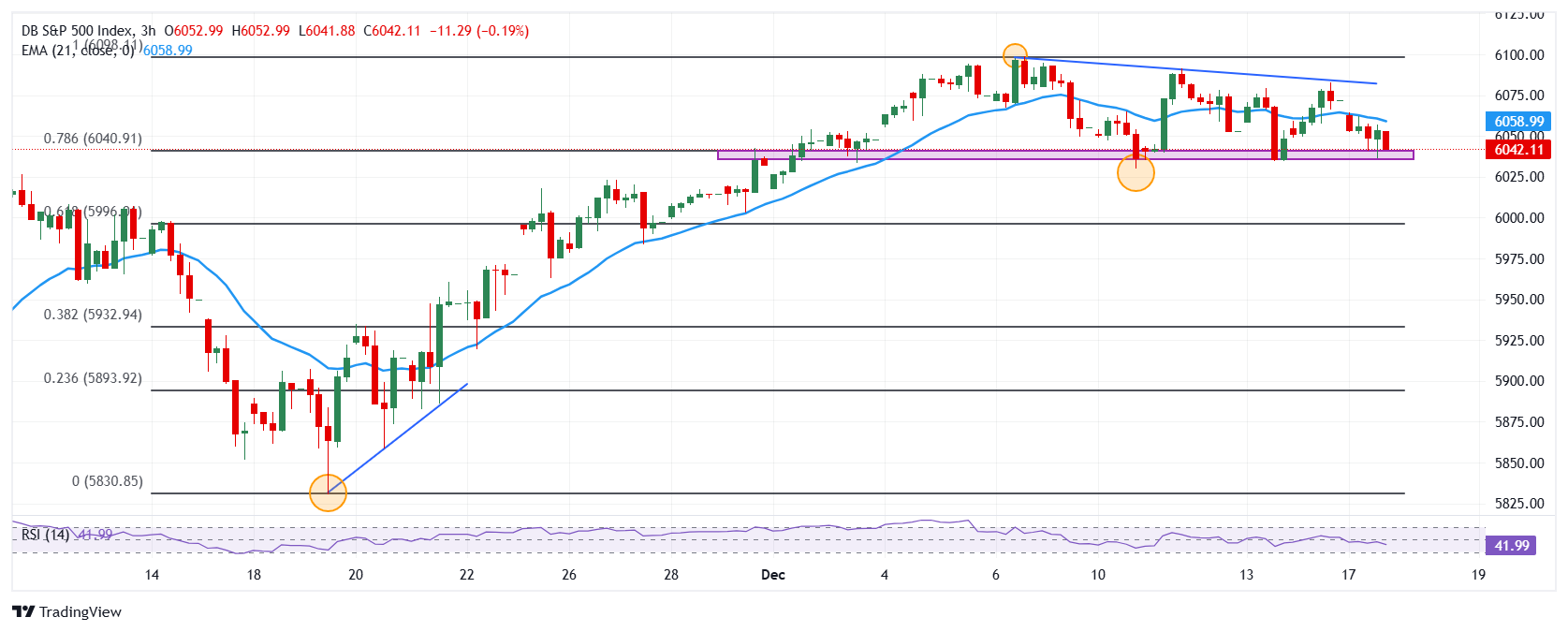- The S&P 500 stock index loses 0.40%, reaching the lows of December 13 at 6,036.
- Amentum Holdings (AMTM) shares plummet 10.72% on the day, hitting one-month lows.
- Humana (HUM) shares fall 8.60% daily, visiting October 7 lows of $237.06.
- Retail sales rose 0.7% in November, above market projections.
The S&P 500 set a day’s high at 6,064, finding sellers that took the index to a two-day low of 6,036. Currently, the S&P 500 is trading at 6,045, down 0.40% on the day.
Amentum Holdings and Humana drag the S&P 500 into the negative zone
Amentum Holdings (AMTM) stock reported revenue of $3.57 billion and earnings per share of $0.47. However, AMTM shares are down 10.72% today, trading at $21.38 at the time of writing amid concerns about next year’s revenue as company officials await the closure of certain government programs. . In the same vein, Humana (HUM) shares fell 8.60%, signing their second consecutive session down, reaching lows of more than two months, not seen since October 7 at $237.06.
According to the US Census Bureau, November retail sales rose 0.7%, beating consensus expectations of 0.5%. On the other hand, industrial production contracted 0.1% in the same period, worsening analysts’ projections of a 0.3% increase.
Investors remain focused on the Federal Reserve’s interest rate decision due tomorrow, with the market expecting a 25 basis point cut to 4.50% from 4.75%.
Levels to consider in the S&P 500
The S&P 500 has formed a series of lower highs in the short term, highlighted by resistance at 6,097, given by the all-time high reached on December 6. The closest support is at the 6,054 December 10 low in convergence with the 78.6% Fibonacci retracement. The next key support is at 5,830, the pivot point of November 19.
S&P 500 3-hour chart

S&P 500 FAQs
The S&P 500 is a widely followed stock index that measures the performance of 500 public companies and is considered a broad measure of the US stock market. The influence of each company in the calculation of the index is weighted based on market capitalization. This is calculated by multiplying the number of listed shares of the company by the share price. The S&P 500 Index has achieved impressive returns: $1.00 invested in 1970 would have produced a return of almost $192.00 in 2022. The average annual return since its inception in 1957 has been 11.9%.
Companies are selected by committee, unlike other indices where they are included based on established standards. Still, they must meet certain eligibility criteria, the most important of which is market capitalization, which must be equal to or greater than $12.7 billion. Other criteria are liquidity, domicile, market capitalization, sector, financial viability, listing time, and representation of the sectors of the United States economy. The nine largest companies in the index represent 27.8% of the index’s market capitalization.
There are several ways to trade the S&P 500. Most retail brokers and spread betting platforms allow traders to use Contracts for Difference (CFDs) to place bets on price direction. In addition, you can buy index funds, mutual funds and exchange-traded funds (ETFs) that track the price of the S&P 500. The most liquid of the ETFs is the London Stock Exchange ETF. The most liquid of the ETFs is State Street Corporation’s SPY. The Chicago Mercantile Exchange (CME) offers futures contracts on the index and the Chicago Board of Options (CMOE) offers options, as well as ETFs, inverse ETFs, and leveraged ETFs.
There are many factors that drive the S&P 500, but primarily it is the aggregate performance of its component companies, revealed in their quarterly and annual earnings reports. US and global macroeconomic data also contribute, influencing investor sentiment, which if positive, drives earnings. The level of interest rates, set by the Federal Reserve (Fed), also influences the S&P 500, as it affects the cost of credit, on which many companies largely depend. Therefore, inflation can be a determining factor, as well as other parameters that influence the decisions of the Federal Reserve.
Source: Fx Street
I am Joshua Winder, a senior-level journalist and editor at World Stock Market. I specialize in covering news related to the stock market and economic trends. With more than 8 years of experience in this field, I have become an expert in financial reporting.







